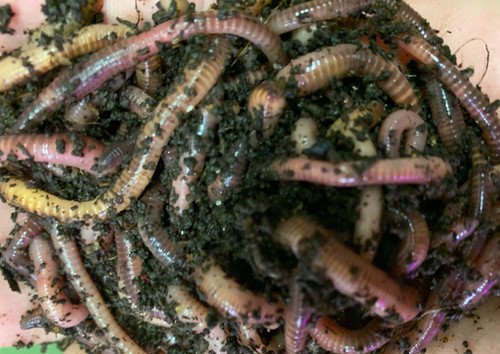
Imagine you’re a gardener, and you want your plants to thrive. If your soil is off, whether from chemicals or poor structure, your plants will struggle. By studying *Eisenia hortensis*, we can learn a lot about what’s going on beneath the surface. This article aims to explore how these little worms act as bioindicators and what that means for environmental monitoring. Let’s dig in!
What is Eisenia Hortensis?
*Eisenia hortensis*, also known as the European nightcrawler, is a species of earthworm that thrives in rich, moist soil. This worm is particularly notable because it’s often used in composting and as fishing bait. It can grow up to 4 inches long and has a distinctive reddish-brown color. But beyond its utility for gardeners and anglers, this worm possesses a unique ability to indicate soil health.
These worms are not just common garden dwellers; they have a significant role in the ecosystem. They help aerate the soil, enhance nutrient cycling, and improve soil structure. Without them, our soil would become compacted and less hospitable for plants. So, when we talk about *Eisenia hortensis* in the context of environmental monitoring, we’re tapping into a deeper understanding of how living organisms contribute to the overall health of our environment.
How Can Eisenia Hortensis Indicate Soil Health?
Think of *Eisenia hortensis* as a biofeedback mechanism for the soil. Their presence, absence, or even behavior can tell us a lot about the soil conditions. When these worms flourish, it generally indicates that the soil is rich in organic matter and free from harmful pollutants. Conversely, if you notice fewer worms, it could be a warning sign that the soil is unhealthy or contaminated.
But how exactly do these worms respond to their environment? They’re quite sensitive to changes in soil pH, temperature, and moisture. For instance, high levels of heavy metals or pesticides can lead to a decline in worm populations. So, by monitoring their numbers and behavior, we can gain insight into the levels of pollutants and the overall health of the soil.
Using Eisenia Hortensis in Environmental Monitoring
Employing *Eisenia hortensis* for environmental monitoring involves a few straightforward methods. One common approach is to conduct a soil bioassay, where the abundance and behavior of the worms are recorded in relation to the levels of various contaminants. You might be wondering how this actually works. Here’s a simple breakdown:
1. Collect Soil Samples: Gather soil samples from different locations in your study area.
2. Introduce the Worms: Place a controlled number of *Eisenia hortensis* into each sample.
3. Monitor Conditions: Keep track of conditions like moisture and temperature, and allow the worms to live in the samples for a specific period.
4. Assess Outcomes: After the test period, evaluate the health of the worms and any changes in their behavior.
This method can reveal significant information about the soil’s health and its ability to support life. It’s a hands-on way to understand the impact of human activities on the environment.
Advantages of Using Eisenia Hortensis for Bioindication
There are several compelling reasons to choose *Eisenia hortensis* as a bioindicator for environmental studies:
– Sensitivity to Contaminants: These worms can respond to a range of pollutants, including heavy metals and organic contaminants. Their reactions can help pinpoint specific issues within an ecosystem.
– Cost-Effective: Monitoring soil health using *Eisenia hortensis* doesn’t require expensive technology. It’s a straightforward, natural approach that can yield valuable data without a hefty price tag.
– Ecological Relevance: Because *Eisenia hortensis* is part of the soil ecosystem, studying them provides direct insights into the health of that ecosystem, making findings particularly meaningful.
Using *Eisenia hortensis* helps bridge the gap between complex environmental science and everyday observations. You don’t need a PhD to see how these worms react to their environment; you just need a keen eye.
Limitations and Considerations
While *Eisenia hortensis* is an excellent bioindicator, it’s important to recognize its limitations. Here are a few things to keep in mind:
– Environmental Variability: Worm populations can naturally fluctuate due to seasonal changes or varying moisture levels. This means that a decline isn’t always due to pollution.
– Species-Specific Responses: Different species of earthworms may react differently to contaminants. It’s essential to consider local biodiversity and choose the appropriate species for your studies.
– Soil Type Interactions: The type of soil can influence earthworm behavior and health. For instance, sandy soils may not support the same populations as loamy soils, which could skew results.
Understanding these limitations is crucial for interpreting the data you gather and for making informed decisions based on your findings.
The Future of Soil Monitoring with Eisenia Hortensis
Looking ahead, there’s a growing interest in using *Eisenia hortensis* for more comprehensive environmental assessments. As sustainability becomes a more pressing issue, scientists and environmentalists are increasingly turning to bioindicators to measure soil health and ecosystem stability.
By integrating advanced technology, like remote sensing and genetic analysis, researchers can enhance the traditional methods of monitoring these worms. Picture this: scientists could monitor worm populations in real-time, mapping out soil health across vast areas. It’s an exciting frontier that combines the simplicity of nature with the power of technology.
As we face environmental challenges, leveraging organisms like *Eisenia hortensis* for monitoring can help inform better practices and policies to protect our planet.
In the grand tapestry of nature, *Eisenia hortensis* plays a vital role that goes beyond enriching our gardens. These unassuming earthworms are powerful bioindicators, offering crucial insights into soil health and environmental conditions. By using them for environmental monitoring, we can take proactive steps toward understanding and improving our ecosystems.
So, if you’re ever wondering about the health of your garden or the local environment, consider the worms beneath your feet. They could be telling you a story—one that’s essential for both the soil and the plants we all depend on. Keep digging and stay curious!
